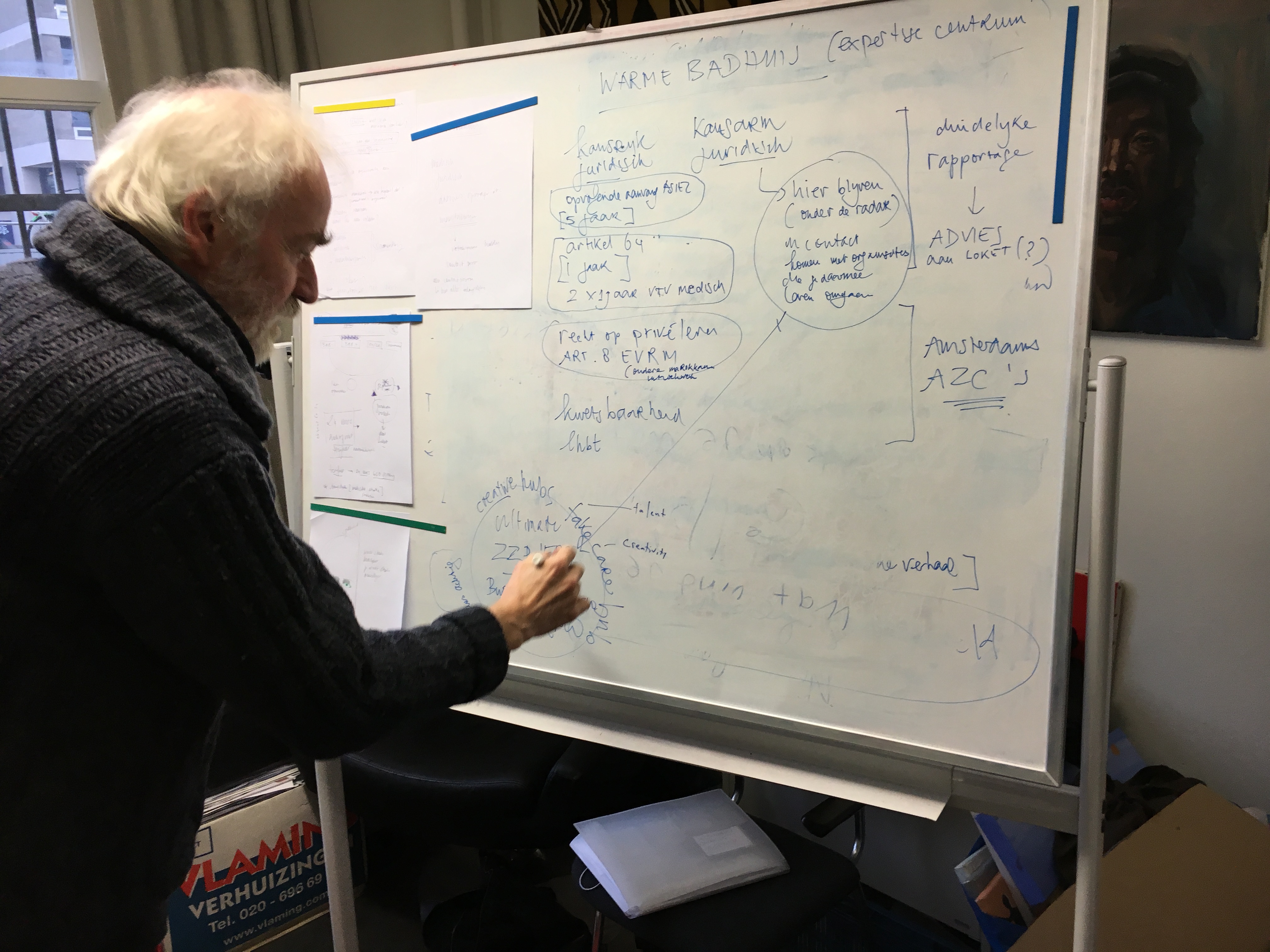Voor Amsterdammers zonder de juiste verblijfsdocumenten kan de gefragmenteerde aanpak het bijzonder moeilijk maken om de noodzakelijke informatie, hulp en ondersteuning te vinden. Er zeer veel verschillende organisaties – een lappendeken zoals iemand het noemde – met elk met hun eigen procedures, databases en ondersteuning, wat het navigeren door het systeem en de stad erg ingewikkeld maakt.
De Lappendeken, dat is de overheid. Doordat er geen sluitend systeem is voor ongedocumenteerde mensen nemen betrokken organisaties, mensenrechtenactivisten, bezorgde burgers die het onrecht zien het met hen – en voor hen – op. Sommigen van hen willen de stichtingen en/of zichzelf weer opheffen als het doel bereikt is, anderen lijken last the hebben van het White Savior Syndrom – willen nodig blijven; of anderen zoeken de samenwerking op om samen te strijden tegen de uitsluiting, discriminatie en het racisme.
Wat betreft stroomlijnen van fragmentatie:
Van EgoSysteem naar EcoSysteem
Een oplossing zou kunnen zijn om meer samenwerking en coördinatie tussen NGO’s en lokale overheid te faciliteren. Nationale overheid? Vergeet het voorlopig maar. Wie zou dat doen? Fondsen- of subsidieverstrekkers? Die hebben ook hun eigen uitgangspunten en strategische plannen. We draaien in een kring.
Toch helpt samenwerken bij het creëren van een meer gestroomlijnd en toegankelijk systeem voor en door ongedocumenteerde mensen. Dat houdt in: niet alleen met de grote NGO’s, maar ook de kleinere, en uiteraard de ongedocumenteerde mensen zelf.
Laat het ego systeem los, en werk in een eco systeem…. Dat is knap lastig blijkt iedere keer weer. Daar is de (fondsen)wereld niet op ingericht: deze ‘infinite game’. Toch hier wat aanbevelingen.
Wat helpt tegen die lappendeken die de overheid is?
↓
Informatie en Advocacy: Het verstrekken van duidelijke, toegankelijke informatie over diensten en rechten is cruciaal. Dit kan via online tools (bij voorkeur niet te veel, en met actuele informatie), folders in verschillende talen, of informatiepunten – hubs – in de stad. Advocacy- en actiegroepen – ook van ongedocumenteerde mensen zelf – zijn essentieel in het vergroten van het bewustzijn bij onwetende Amsterdammers, van solidariteit en bij beleidsmakers om de situatie van ongedocumenteerde mensen te verbeteren: hen toegang te geven tot de stad. Signalen te versterken. Activisten zijn cruciaal, omdat ze geen hulpverlener (willen) zijn. Daar is de equity geborgd.
↓
Samenwerking tussen organisaties: Omdat er al veel organisaties zijn die zich inzetten voor ongedocumenteerde mensen, zou een betere coördinatie en samenwerking tussen deze organisaties de effectiviteit kunnen verhogen. Het delen van kennis, informatie en ‘best practices’ kan helpen bij het creëren van een meer samenhangend netwerk. En vergeet de ongedocumenteerde mensen zelf niet in het vormgeven van samenwerkingen; werk niet top-down.
↓
Toegankelijke informatie en ondersteuning: Solidariteit en professionaliteit is ook essentieel voor ongedocumenteerde mensen, vooral als het gaat om zaken als juridische procedures, signalering, mensenrechten, en toegang tot voorzieningen, zoals wonen, educatie, informatie. Juridische en maatschappelijke organisaties (of ‘hubs’) kunnen hierbij een belangrijke rol spelen.
↓
Betrokkenheid van de lokale overheid: Ondanks de beperkingen en uitdagingen op nationaal niveau, kunnen lokale overheden – in dit geval de gemeente Amsterdam – een actieve rol spelen bij het ondersteunen van ongedocumenteerde mensen. En dan met hen de hulp opzetten, niet vanuit de NGO’s. Dit kan bijvoorbeeld door het financieren van opvangplaatsen, het mogelijk maken van huisvesting, en volledige toegang tot stedelijke overheidsdiensten, een mogelijkheid tot een digitale ID, bankieren, zelforganisatie, werk, of het faciliteren van samenwerking tussen ongedocumenteerde Amsterdammers zelf en verschillende organisaties.
↓
Ondersteuningsnetwerken opbouwen: Het opbouwen van ondersteuningsnetwerken binnen communities kan helpen. Dit kan variëren van informele netwerken die elkaar helpen tot meer gestructureerde programma’s die zich richten op specifieke doelen zoals werk, gezondheidszorg, onderwijs, of kinderen.
↓
Bewustwording: Het is ook belangrijk om het publieke bewustzijn te vergroten over de uitdagingen, kansen en problemen waarmee ongedocumenteerden dagelijks worden geconfronteerd. Of hoe de overheid een uitsluitend systeem gemaakt heeft, welke bijdrage ongedocumenteerde mensen aan de stad leveren. Hoe ze hier wonen en werken. Dit kan leiden tot stadsbrede empathie en een concrete solidariteit die duurzaam is.
Mooi om dit bedenken, maar zolang het systeem gebouwd is op ongelijkheid, vanuit overheden, of dat zelfs fondsen het makkelijker vinden grotere NGO’s te steunen of hun strategische uitgangspunten aan hen te delegeren. Het is geen ecosysteem, helaas leeft in de NGO wereld de ‘winners mentaliteit’. Het werven van fondsen is een wedstrijd geworden voor sommigen. Wie krijgt het geld en wie niet? Wie heeft het beste idee? Het gaat soms zo ver dat stichtingen die de beste interne infrastructuur hebben om fondsen aan te vragen ideeën inzetten van kleine NGO’s om zelf verder te komen, komen ‘brainpicken’, of dit nu een bevestigd gerucht is of niet, dit is wat speelt. Zo wordt het een onveilige omgeving, en dat is spijtig. Wie daartegen in verzet gaat: dan ontstaan nieuwe stichtingen die het anders willen, hun eigen invalshoek kiezen. Mogelijk dat zij dezelfde cyclus doorlopen als de groter geworden NGO’s. Willen ze klein blijven, willen ze zichzelf t.z.t. opheffen? Of worden ze ook afhankelijk van overheidsgeld, donaties en fondsen. Vertellen ze hun eigen verhaal, namens ongedocumenteerde mensen? Willen ze nodig blijven en geven ze een beetje kennis, maar niet alle kennis?
